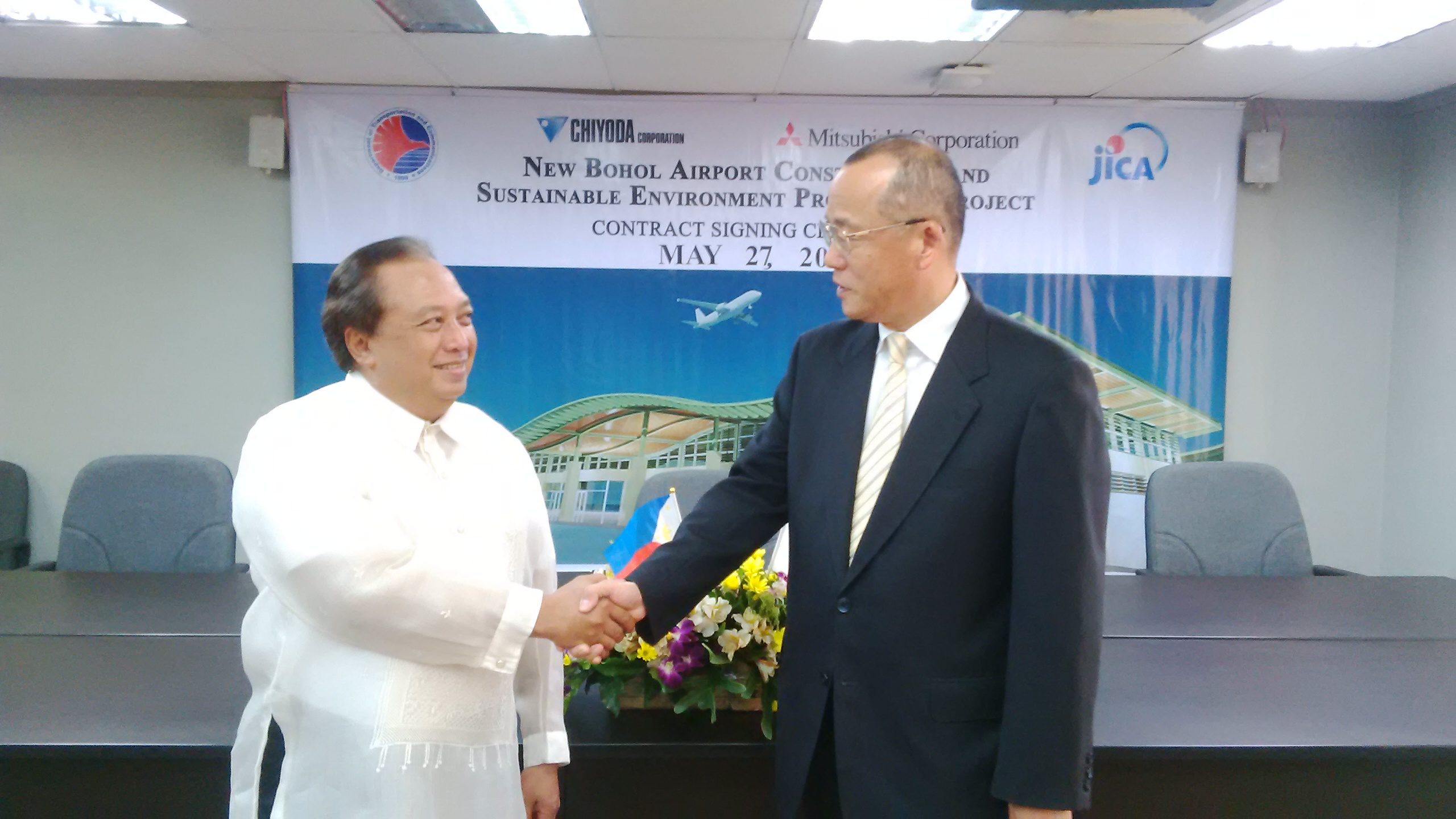SUMMARY
This is AI generated summarization, which may have errors. For context, always refer to the full article.

MANILA, Philippines – A “world-class, eco-friendly” airport that is 10 times bigger than the current Bohol gateway, Tagbilaran Airport, will rise by 2018.
This was after Japanese joint venture Mitsubishi Corporation and Chiyoda Corporation bagged the P7-billion ($156.48-million), 8,800-square-meter (sqm) New Bohol (Panglao) Airport Project early this year.
The Japanese consortium and the officials of the Department of Transportation and Communications (DOTC) today, May 27, signed the concession agreement for the construction of the New Bohol airport, paving the way to start the construction works.
“Construction will start in June. We appreciate if the airport can be done in one-and-a-half years,” DOTC Secretary Joseph Emilio Abaya said.
In response, Chiyoda Associate Director Tadayoshi Kimura said: “We have already started some preparatory works at the site, so we can immediately respond to notice of award and notice to proceed, which will be issued soon.”
The New Bohol Airport will replace the 850-square-meter Tagbilaran airport, which catered to around 789,800 passengers in 2013, making it the 11th busiest airport in the country.
Asked about plans for the old Tagbilaran airport, Abaya said, “We will coordinate with the province of Bohol on the possibilities once it is closed down.”
The old airport can be converted for commercial use or to accommodate locators from the information technology and business process outsourcing industries, which are spurring tourism in Bohol, Abaya added.
The New Bohol (Panglao) Airport is expected to be completed within 30 months, or in 2017 to early 2018. It will have a floor area of around 8,800 square meters, making it 10 times bigger than the old one.
The new, eco-friendly airport, according to Abaya, is seen to boost the annual capacity to 1.7 million passengers.
“Tourists in Bohol continue to grow each year that passes. Unfortunately, the current airport may not be able to accommodate the increase over time,” Abaya said. “This gives us the need to cater to the increasing number of tourists and this means modernizing and expanding the airport with a design that is of international standards.”
Abaya added that the project will be the “first greenfield airport under the Aquino administration, which has environment-friendly and energy-saving features.”

Financed by ODA
The construction of the New Bohol airport is financed by an official development assistance (ODA) loan from the Japan International Cooperation Agency (JICA).
“Our past experience shows that implementing a project of big magnitude such as construction of a new airport from scratch is not an easy task. At times, project implementation challenges can test the harmony between contracting parties, which, if not resolved, may lead to delays in project progress and more so the postponement of delivering the intended benefits to the people,” JICA Chief Representative Niwa Noriaki said in his speech during the signing.
“Hence, JICA trusts that Chiyoda Mitsubishi joint venture can rise up to such challenges and work together in a mutually acceptable way for the overall good of the project,” Noriaki added.
Operations and maintenance of New Bohol in PPP
The operations and maintenance (O&M) of the New Bohol airport is being auctioned off as part of the P108.19-billion ($2.42-billion) deal to develop, O&M 5 regional airports under the public-private partnership (PPP) thrust.
Other than New Bohol, Bacolod-Silay, Iloilo, Laguindingan and Davao airports are included in the PPP bundle.
The transportation department originally set a May 18 deadline for the submission of pre-qualification documents. The department, however, has moved the deadline indefinitely, saying that it has to revise the bidding terms.
“We’re doing it (ITPB review) almost simultaneously so it’s part of the process,” Abaya said.
But when asked when the target approval of the revised terms will be, he replied: “I have to check. I haven’t gotten word yet.”
Five groups, thus far, have bought bid documents for the bundled airports under PPP, namely: the consortium of Metro Pacific Investments Corporation and JG Summit Holdings Incorporated; San Miguel Corporation; Aboitiz Equity Ventures Incorporated; the group of Megawide Construction Corporation and Bangalore-based GMR Infrastructure Limited; and air cargo warehousing firm Philippine Skylanders Incorporated. – Rappler.com
$1 = P44.72
Being a travel hotspot in the Philippines, it is only appropriate to have a world-class, eco-friendly airport in Bohol. Experience the region famous for the Chocolate Hills, nature trails, and diverse wildlife while still saving on airfare and accommodations. Click here for discounts and coupons.
Add a comment
How does this make you feel?
There are no comments yet. Add your comment to start the conversation.